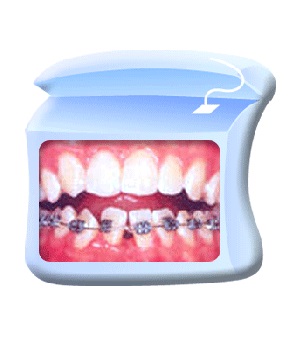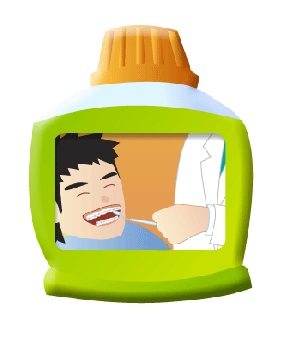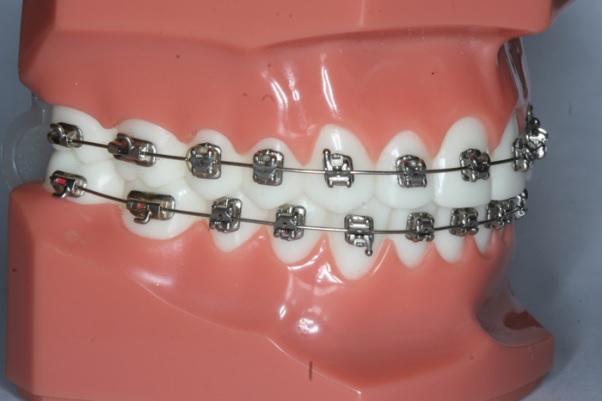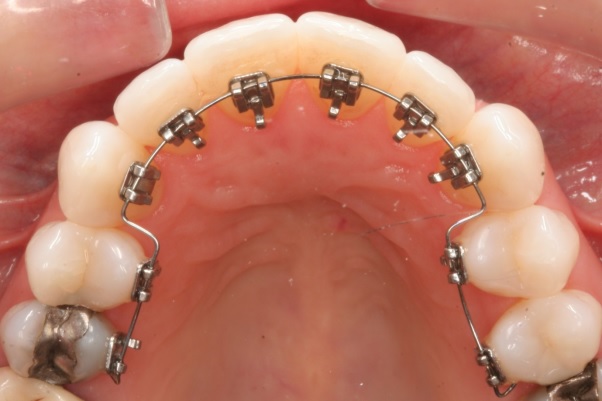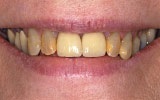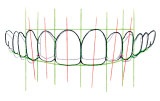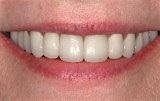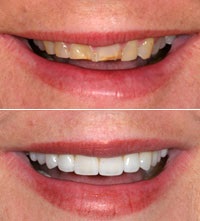Fixed orthodontic Appliances
– How long does a fixed orthodontic treatment take?
The overall duration lasts for about 1.5 to 3 years. The actual time needed depends on the complexity of treatment.
Orthodontic treatment in young children is known as interceptive orthodontics, and it can begin as early as age 6 or 7. At this age, teeth are still developing and the jaw is still growing. That means certain conditions, such as crowding, may be easier to address.
It is important to note that early treatment does not apply to all orthodontic problems; however, it may help in certain cases. Two conditions that require early intervention are crossbites and protruding front teeth. A crossbite can cause the jaws to grow unevenly. Front teeth that stick out may be fractured or injured in an accident, such as a fall.
Early intervention takes advantage of the fact that a child’s jaw is still growing. Early treatment also may be useful when the dental arches and jaws are not in the correct position. Functional appliances may fix or improve these problems. More treatment usually is needed later on, but it may be shorter and less involved.
Kids braces have improved a lot in the past couple of decades. Technology has made them more comfortable and more attractive than the braces most parents remember wearing. They’re also more affordable, meaning many more children have them.
Good dental hygiene is crucial for kids with braces and other dental appliances. Three to four times per day, have your child rinse with water to loosen food that might be caught in the braces, then brush thoroughly. Each night before bed, have your child floss their teeth and then rinse with a fluoride rinse to help keep the teeth strong and healthy.
Once per day, you should also help your child floss, which helps loosen food debris and plaque at and under the gum line that would otherwise harden into tartar. It can also help reach the nooks and crannies in the teeth that might be difficult to reach with a toothbrush. Flossing with braces can be difficult, but you can use many options to help ensure the gums stay healthy. Talk to your child’s orthodontist or dentist for oral care recommendations.
Every six months, take your child to the dentist for a cleaning and a checkup. The dentist can point out areas that need more attention, and help make sure you’re keeping your child’s teeth healthy and clean in and around the braces. Often, your dentist or hygienist can suggest helpful tools or ideas to keep your child’s teeth healthy while the braces are on.
Although treatment plans are customized for each patient, most wear their braces from one to three years, depending on the oral care issues that need correcting. This is followed by a period of wearing a “retainer,” which holds teeth in their new positions. Although a little discomfort is expected during treatment, today’s braces are more comfortable than ever before.
A palatal expander may be used to expand the child’s upper dental arch so there is more room for teeth to grow in, thus reducing crowding in the mouth. The procedure involves the installation of the appliance. It consists of two pieces of plastic attached to both sides of the upper molars, and an expansion screw. When the expansion screw is turned, the device pushes the two sides away from each other, thus gradually widening the jaw and making room for the child’s adult teeth. Once the arch is the proper size, there’s a better chance that the adult teeth will come in in a better position.
Modern patients are very concerned with their appearance during orthodontic treatment
The word “lingual” means tongue. Lingual braces (also known as invisible braces) are attached to the inside surfaces of the teeth that face the tongue. There they are practically invisible from the outside, even up-close. What are the advantages and disadvantages of lingual braces, and who is eligible for this treatment option?
Besides being invisible, lingual braces have other advantages. First, they are far more capable and efficient than clear aligners for complex movements like correcting rotations, changing the heights of teeth, and closing extractions spaces. Additionally, even if oral hygiene is not ideal, any discoloration that occurs (white spots) will be on the inside of the teeth where it is not visible.
As you might imagine, there are also challenges associated with having braces on the inside of the teeth. It takes a couple of weeks to get used to having braces next to your tongue. The brackets and wires will feel a little rough initially and they may affect your speech for a while. Lingual braces are also more difficult to keep clean. In fact if you have periodontal problems, inside braces may actually make things worse. Invisible braces may not be possible for patients with short crowns. Your orthodontist will determine this at your initial exam.
A smile makeover is the process of improving the appearance of the smile through one or more cosmetic dentistry procedures, such as dental veneers, composite bonding, tooth implants and teeth whitening.
The dentist as artist can help a patient visualize the potential results of proposed treatment recommendations using photographic images, tracing analysis, and even computer simulation. While these pictures may differ slightly from the eventual outcome, the dentist can utilize drawings or digitized images to describe particular procedures and to compare how they could affect the final look.
By altering the relative size, edge design, or angulation of the front teeth, the final effect may appear “sexy,” “sporty,” or “sophisticated.” Of course, the enjoyment of all things possible must eventually rub shoulders with the limits of reality. At this point, the cosmetic dentist must take up the consideration of prognosis — the predictability for achieving and maintaining every aspect of the desired outcome. Options may range from limited-scope to all-inclusive, less expensive to more elaborate, invasive to conservative, or durable to shorter term. Inevitably career, financial, and other life activity issues may become part of the discussion. Other realities like age and overall health may play a factor. Some procedures make sense for some patients while they may not be as advantageous for others. Here the dentist draws on both clinical experience and scientific evidence to make recommendations that are ultimately in the patient’s best interest.In crafting the most appropriate smile design, each person must consider what he or she is willing to pursue to achieve the future they have envisioned? Is the commitment to time and money available to complete an extensive design plan? Is there a willingness to accept an enhanced but more limited improvement anticipated with a less extensive design plan? In the end, it boils down to the perspective of value for the each patient. Eventually, the dentist and patient work together to determine the best course of action as they collaborate to achieve a practical and realistic smile enhancement.
Putting The Plan Into Action
To this point, the smile design is still on paper — or perhaps a computer screen. Once the plan is finalized, though, the real work begins: the actual procedures the cosmetic dentist uses to create the patient’s brand new smile.You might be surprised at the wide array of techniques now at a cosmetic dentist’s disposal, but most have been in development for decades. Some techniques, like whitening, bonding, veneering or enamel shaping, change the appearance and shape of the patient’s natural teeth. Other techniques like crowns, bridgework and implants provide permanent artificial replacements for missing or abnormal teeth that cannot be corrected with the previously mentioned procedures.
Smile Makeover Considerations
Tooth Color: Silver or amalgam dental fillings can be replaced with natural, tooth-colored composite restorations, while teeth whitening can improve the color of stained or dulled teeth. Tooth color and shading are important considerations during the evaluation of and preparation for various procedures, including porcelain veneers, crowns, bridges, composite bonding and dental implants.
When considering the color of your teeth, keep in mind that dark or discolored teeth may suggest an aged mouth. A well-shaped smile comprised of bright, white teeth lends to a youthful appearance. The shade your dentist selects for teeth whitening and veneers is carefully evaluated with special consideration given to the tone and color of your face and hair. Cosmetic dentists are skilled at finding the right balance between providing you with a brighter, whiter smile and maintaining a natural tooth color.
Alignment and Spacing: Teeth that are crooked, overlapping or have gaps between them can be straightened and aligned when necessary through orthodontics or Invisalign and improved with veneers.
Missing Teeth: One or more missing teeth can negatively affect the appearance of your smile – as well as affect your bite and increase your risk for tooth decay – making replacement an integral part of oral health and facial esthetics. Missing teeth can be replaced by dental implants, bridges or partial dentures.
Harmony and Balance: Uneven, chipped and cracked teeth can be cosmetically bonded for an improved appearance, and a gummy smile can be re-contoured to help improve the overall look of the smile.
Fuller Lips, Smile and Cheeks: An unshapely or aging face can be improved or rejuvenated with certain procedures in the smile makeover category, including orthodontics and/or oral maxillofacial surgery.
A cosmetic dentist will work closely with you to develop a treatment plan designed to achieve exactly what you want from your makeover. This treatment plan may consist of many cosmetic and functionally restorative procedures, potentially including teeth whitening, composite bonding, veneers, dental crowns, orthodontics (braces), oral maxillofacial surgery and gummy smile reduction.
Esthetic Components of a Smile Makeover
In addition to the color, alignment and balance of your teeth in the esthetic zone of your smile (the section of upper and lower teeth that show when you smile), there are several attributes of your teeth and smile that your cosmetic dentist will evaluate with you when planning your smile makeover. These include:
Tooth Length: Long teeth lend a youthful appearance. Aging produces wear and tear that often results in shorter teeth, and a gummy smile also can make teeth appear shorter. A smile makeover treatment for shorter teeth may include reshaping and lengthening the two front central teeth with composite bonding or porcelain veneers. If you have a gummy smile, your cosmetic dentist may provide treatment to modify the gum line and lengthen the appearance of the teeth using laser dentistry procedures. You may also be referred to a periodontist for crown lengthening if necessary. Teeth lengthening may also impact your overall facial appearance. For example, shapely, long, square teeth on a round-faced individual can provide a slimming effect.
Smile Line: The smile line is an imaginary line that follows the edges of your upper teeth from side to side, which ideally should be the same as the curve of your lower lip when you smile. This standard point of reference for smile makeovers may be used to help determine how long your new teeth should be.
Tooth Proportions: Your cosmetic dentist will examine your teeth to determine if they are in correct proportion with each other. Most people recognize a pleasing smile as one in which the two central front teeth are dominant and have a width-to-length ratio of 4-to-5. This proportion guides the length and width of other teeth in the esthetic zone so that the smile line appears balanced.
Tooth Texture and Characterization: Cosmetic dentists performing smile makeovers are adept at blending functionality and esthetics. An artistic dentist can characterize your crowns or veneers to create a more feminine or a more masculine appearance, in addition to matching the look and feel of natural teeth or those you’ve seen in photographs.
The Life of Your Smile Makeover
Cosmetic dentistry procedures require regular oral hygiene care and may require maintenance over time. For example, teeth whitening must be repeated on occasion in order to maintain brightness. Porcelain veneers may chip or break off and need replacement. Permanent composite bonding may stain and require enhancement or replacement. Dental crowns typically require replacement after 10 to 15 years. Gummy smile improvements may also require enhancement over time.
Your ceramist, lab technician and the materials chosen by your dentist also impact the longevity of your smile makeover. To achieve the best results, take special care in selecting your cosmetic dentist and inquiring about your material options.
Gum Depigmentation- (Gum Bleaching)
The most common cause of darker pigments in the gums is genetics. Excess melanin can build up in the gums, making them look brown or black instead of pink. This is more common in certain ethnic groups like people with African or Middle Eastern ancestry. The extra pigment does not indicate any disease or dysfunction. Patients seek treatment because of an aesthetic preference for pink gums that showcase their teeth better.
Other causes for dark gums include smoking, side effects from certain medications and possible effect of amalgam fillings on the gum.
The main guideline is simply that the gums must be healthy. We can assess your gum health at the free consultation that you have with our dentist.
This cosmetic treatment is not suitable for:
Laser Gum Depigmentation vaporizes and removes a thin top layer of the gum tissue, destroying the cells that produce melanin. As new tissue is created during healing, it tends to be pink rather than brown. The treatment may require a local anaesthetic injection and has a short recovery time with manageable discomfort. Sometime depending on the colour and depth of the dark patch, it could take several sessions to achieve the desired degree of lightening.
Bruxism (BRUK-siz-um) is a condition in which you grind, gnash or clench your teeth. If you have bruxism, you may unconsciously clench your teeth together during the day, or clench or grind them at night (sleep bruxism).
Sleep bruxism is considered a sleep-related movement disorder. People who clench or grind their teeth (brux) during sleep are more likely to have other sleep disorders, such as snoring and pauses in breathing (sleep apnea).
Mild bruxism may not require treatment. However, in some people, bruxism can be frequent and severe enough to lead to jaw disorders, headaches, damaged teeth and other problems.
Because you may have sleep bruxism and be unaware of it until complications develop, it’s important to know the signs and symptoms of bruxism and to seek regular dental care.
Signs and symptoms of bruxism may include:
See your doctor or dentist if:
Doctors don’t completely understand what causes bruxism. Possible physical or psychological causes may include:
These factors increase your risk of bruxism:
In most cases, bruxism doesn’t cause serious complications. But severe bruxism may lead to:
What Can I Do to Stop Grinding My Teeth?
Your dentist can fit you with a mouth guard to protect your teeth from grinding during sleep.
If a sleeping disorder is causing the grinding, treating it may reduce or eliminate the grinding habit.
Other tips to help you stop teeth grinding include:
Specific tips to help a child stop grinding his or her teeth include:



